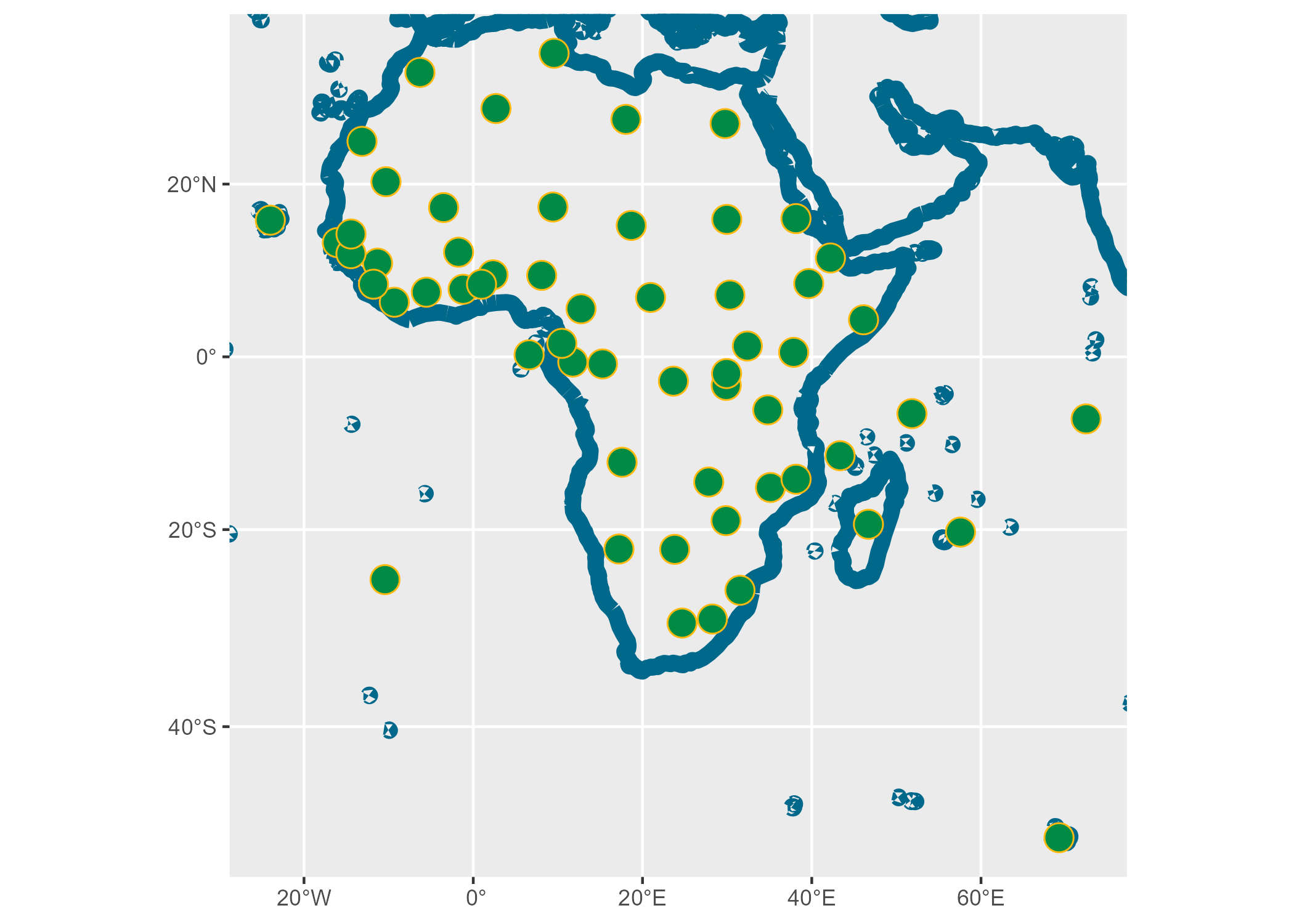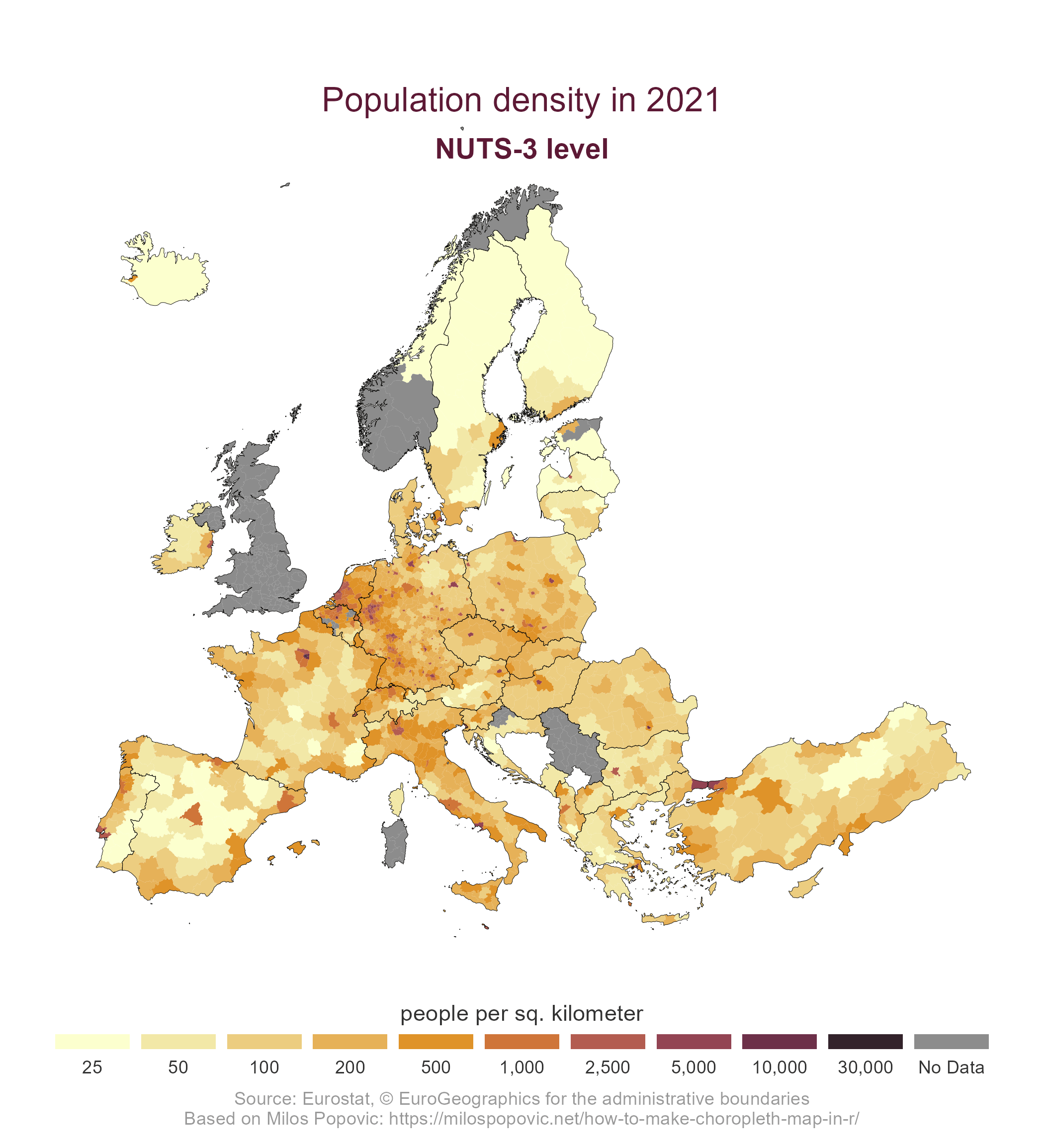

giscoR is an API package that helps to retrieve data from Eurostat - GISCO (the Geographic Information System of the COmmission). It also provides some lightweight data sets ready to use without downloading.
GISCO (FAQ) is a geospatial open data repository including several data sets as countries, coastal lines, labels or NUTS levels. The data sets are usually provided at several resolution levels (60M/20M/10M/03M/01M) and in 3 different projections (4326/3035/3857).
Note that the package does not provide metadata on the downloaded files, the information is available on the API webpage.
Full site with examples and vignettes on https://ropengov.github.io/giscoR/
Install giscoR from CRAN:
install.packages("giscoR")You can install the developing version of giscoR
with:
library(remotes)
install_github("rOpenGov/giscoR")Alternatively, you can install giscoR using the r-universe:
# Enable this universe
options(repos = c(
ropengov = "https://ropengov.r-universe.dev",
CRAN = "https://cloud.r-project.org"
))
install.packages("giscoR")This script highlights some features of giscoR:
library(giscoR)
library(sf)
library(dplyr)
# Different resolutions
DNK_res60 <- gisco_get_countries(resolution = "60", country = "DNK") %>%
mutate(res = "60M")
DNK_res20 <-
gisco_get_countries(resolution = "20", country = "DNK") %>%
mutate(res = "20M")
DNK_res10 <-
gisco_get_countries(resolution = "10", country = "DNK") %>%
mutate(res = "10M")
DNK_res03 <-
gisco_get_countries(resolution = "03", country = "DNK") %>%
mutate(res = "03M")
DNK_all <- bind_rows(DNK_res60, DNK_res20, DNK_res10, DNK_res03)
# Plot ggplot2
library(ggplot2)
ggplot(DNK_all) +
geom_sf(fill = "tomato") +
facet_wrap(vars(res)) +
theme_minimal()
# Labels and Lines available
labs <- gisco_get_countries(
spatialtype = "LB",
region = "Africa",
epsg = "3857"
)
coast <- gisco_get_countries(
spatialtype = "COASTL",
epsg = "3857"
)
# For zooming
afr_bbox <- st_bbox(labs)
ggplot(coast) +
geom_sf(col = "deepskyblue4", size = 3) +
geom_sf(data = labs, fill = "springgreen4", col = "darkgoldenrod1", size = 5, shape = 21) +
coord_sf(
xlim = afr_bbox[c("xmin", "xmax")],
ylim = afr_bbox[c("ymin", "ymax")]
)
An example of a labeled map using ggplot2:
ITA <- gisco_get_nuts(country = "Italy", nuts_level = 1)
ggplot(ITA) +
geom_sf() +
geom_sf_text(aes(label = NAME_LATN)) +
theme(axis.title = element_blank())
An example of a thematic map plotted with the ggplot2
package. The information is extracted via the eurostat
package. We would follow the fantastic approach presented by Milos Popovic on this
post:
# Get shapes
nuts3 <- gisco_get_nuts(
year = "2016",
epsg = "3035",
resolution = "3",
nuts_level = "3"
)
# Group by NUTS by country and convert to lines
country_lines <- nuts3 %>%
group_by(
CNTR_CODE
) %>%
summarise(n = n()) %>%
st_cast("MULTILINESTRING")
# Use eurostat
library(eurostat)
popdens <- get_eurostat("demo_r_d3dens")
popdens <- popdens[popdens$time == "2018-01-01", ]
# Merge data
nuts3.sf <- merge(nuts3,
popdens,
by.x = "NUTS_ID",
by.y = "geo",
all.x = TRUE
)
# Breaks and labels
br <- c(0, 25, 50, 100, 200, 500, 1000, 2500, 5000, 10000, 30000)
nuts3.sf$values_cut <- cut(nuts3.sf$values,
breaks = br,
dig.lab = 5
)
labs_plot <- prettyNum(br[-1], big.mark = ",")
# Palette
pal <- hcl.colors(length(br) - 1, "Lajolla")
# Plot
ggplot(nuts3.sf) +
geom_sf(aes(fill = values_cut), size = 0, color = NA, alpha = 0.9) +
geom_sf(data = country_lines, col = "black", size = 0.1) +
# Center in Europe: EPSG 3035
coord_sf(
xlim = c(2377294, 7453440),
ylim = c(1313597, 5628510)
) +
labs(
title = "Population density in 2018",
subtitle = "NUTS-3 level",
caption = paste0(
"Source: Eurostat, ", gisco_attributions(),
"\nBased on Milos Popovic: https://milospopovic.net/how-to-make-choropleth-map-in-r/"
)
) +
scale_fill_manual(
name = "people per sq. kilometer",
values = pal,
labels = labs_plot,
drop = FALSE,
guide = guide_legend(
direction = "horizontal",
keyheight = 0.5,
keywidth = 2.5,
title.position = "top",
title.hjust = 0.5,
label.hjust = .5,
nrow = 1,
byrow = TRUE,
reverse = FALSE,
label.position = "bottom"
)
) +
theme_void() +
# Theme
theme(
plot.title = element_text(
size = 20, color = pal[length(pal) - 1],
hjust = 0.5, vjust = -6
),
plot.subtitle = element_text(
size = 14,
color = pal[length(pal) - 1],
hjust = 0.5, vjust = -10, face = "bold"
),
plot.caption = element_text(
size = 9, color = "grey60",
hjust = 0.5, vjust = 0,
margin = margin(t = 5, b = 10)
),
legend.text = element_text(
size = 10,
color = "grey20"
),
legend.title = element_text(
size = 11,
color = "grey20"
),
legend.position = "bottom"
)
Some data sets (as Local Administrative Units - LAU, or
high-resolution files) may have a size larger than 50MB. You can use
giscoR to create your own local repository at a given local
directory passing the following function:
gisco_set_cache_dir("./path/to/location")You can also download manually the files (.geojson
format) and store them on your local directory.
eurostat package (https://ropengov.github.io/eurostat/). This is an API
package that provides access to open data from Eurostat.sf objectsSome packages recommended for visualization are:
Check the GitHub page for source code.
Contributions are very welcome:
To cite ‘giscoR’ in publications use:
Hernangomez D (2022). giscoR: Download Map Data from GISCO API - Eurostat. https://doi.org/10.5281/zenodo.4317946, https://ropengov.github.io/giscoR/
A BibTeX entry for LaTeX users is
@Manual{R-giscoR,
title = {{giscoR}: Download Map Data from GISCO API - Eurostat},
doi = {10.5281/zenodo.4317946},
author = {Diego Hernangómez},
year = {2022},
version = {0.3.2},
url = {https://ropengov.github.io/giscoR/},
abstract = {Tools to download data from the GISCO (Geographic Information System of the Commission) Eurostat database <https://ec.europa.eu/eurostat/web/gisco>. Global and European map data available. This package is in no way officially related to or endorsed by Eurostat.},
}From GISCO > Geodata > Reference data > Administrative Units / Statistical Units
When data downloaded from this page is used in any printed or electronic publication, in addition to any other provisions applicable to the whole Eurostat website, data source will have to be acknowledged in the legend of the map and in the introductory page of the publication with the following copyright notice:
EN: © EuroGeographics for the administrative boundaries
FR: © EuroGeographics pour les limites administratives
DE: © EuroGeographics bezüglich der Verwaltungsgrenzen
For publications in languages other than English, French or German, the translation of the copyright notice in the language of the publication shall be used.
If you intend to use the data commercially, please contact EuroGeographics for information regarding their license agreements.
This package is in no way officially related to or endorsed by Eurostat.